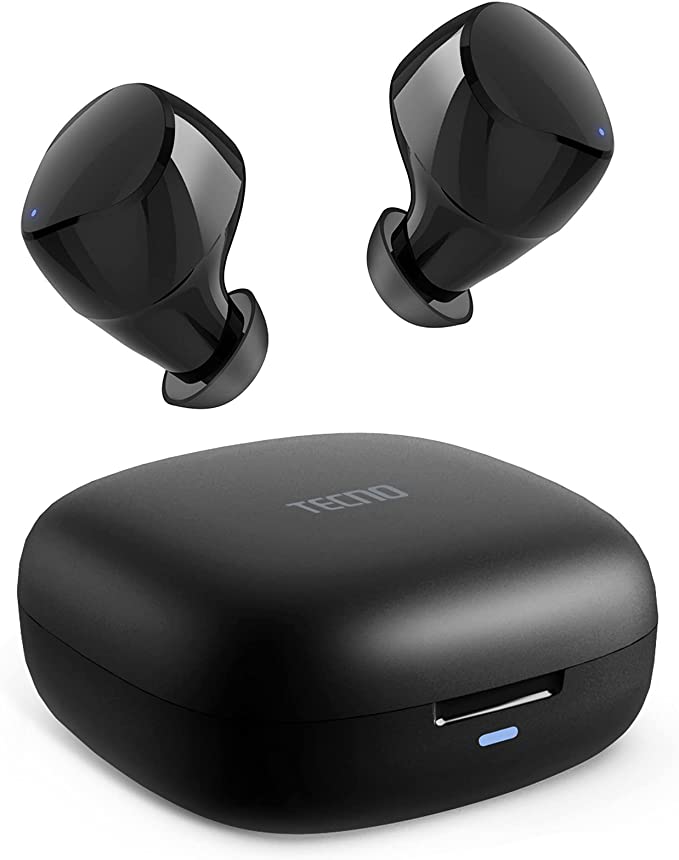Volkano VK-1120 Taurus Series True Wireless Earphones - Affordable True Wireless Earbuds with Impressive Sound
Update on July 2, 2025, 9:34 a.m.
It starts with a glossy white box and the quiet thrill of new technology. Inside, a pair of pristine true wireless earbuds, the Volkano Taurus Series, promise a seamless audio future for the modest price of $34.99. They pair instantly. Music plays. But then, an anomaly. A crisp, clear voice speaks, not with a familiar “Connected,” but with a string of Chinese. In the heart of this modern gadget, a ghost seems to live. This isn’t a horror story, though. It’s a detective story. And that single, unexpected voice prompt is the first clue in a case that will lead us deep into the hidden compromises and surprising truths of the technology we use every day.
Our subject, the Volkano Taurus, presents a compelling blueprint for a budget champion. The box promises Bluetooth 5.0, over 18 hours of playtime with its charging case, and an IPX4 water-resistance rating. On paper, it’s a distillation of everything we’ve come to expect from wireless audio in the 2020s. A decade ago, this feature set would have commanded a premium price. Today, it’s accessible to almost everyone. But as any good detective knows, the blueprint only tells half the story. The real truth is found in the details.

Decoding the Invisible Bridge
The first item on the spec sheet is Bluetooth 5.0. We see this number everywhere, but what does it represent? Its legacy is more interesting than you might think. The name “Bluetooth” honors Harald “Bluetooth” Gormsson, a 10th-century Viking king famed for uniting the disparate tribes of Denmark. In the same spirit, the creators of Bluetooth technology at Ericsson in the 1990s aimed to unite different communication protocols under one universal standard.
Version 5.0, a standard overseen by the Bluetooth Special Interest Group (SIG), represents a significant evolution. It offers a more stable connection, greater range, and better power efficiency than its predecessors. This is the science behind the Taurus’s promise of faster, more stable transmission. But here lies our second clue. For audio to travel across this invisible bridge from your phone to the earbuds, it must be compressed. This is handled by a codec. While high-end earbuds boast of codecs like AAC or aptX, nearly every budget device, likely including the Taurus, relies on the mandatory, universal SBC (Low Complexity Subband Codec).
Think of SBC as a functional, but basic, courier service. It gets the package (your music) delivered, but it’s not a white-glove service. The compression is more aggressive, which can sometimes lead to a perceptible loss in audio detail, especially in complex musical passages. It’s a classic case of “good enough” engineering—a perfectly acceptable compromise to keep costs down, but a compromise nonetheless.

The Heartbeat in a Plastic Shell
Next, we put the 6mm dynamic drivers under our magnifying glass. A dynamic driver is a marvel of miniature engineering—a tiny speaker, really. It uses an electromagnet to vibrate a diaphragm, creating the sound waves that travel to your eardrum. Think of it as a microscopic musician. The 6mm driver is a capable performer, able to produce a full range of sound.
However, having a capable musician is one thing; how they are instructed to play is another. This is the art of “tuning.” Two pairs of earbuds with identical 6mm drivers can sound vastly different based on how the manufacturer has electronically sculpted the sound profile. In the world of high-end audio, engineers spend countless hours tuning drivers to achieve a specific, balanced, and detailed sound signature. In the budget realm, this process is often simplified. The tuning might be geared towards a bass-heavy, crowd-pleasing sound that can mask a lack of subtlety in the mids and highs. The musician is playing the notes, but the nuanced expression might be lost.

A Shield Against the Storm (But Not a Submarine)
The IPX4 rating sounds reassuringly technical. It signifies a degree of protection against the elements, crucial for a device meant for an active lifestyle. To understand what this truly means, we must refer to the official standard, IEC 60529, defined by the International Electrotechnical Commission. This isn’t just a marketing term; it’s a scientific benchmark.
To earn an IPX4 rating, a device must withstand water splashes from any direction. The test involves placing it in an apparatus and subjecting it to an oscillating spray for at least five minutes. This makes the Volkano Taurus a reliable companion for a sweaty gym session or a run in a light drizzle. But here, the boundary is critical. IPX4 does not protect against submersion. It’s a shield, not a submarine. Taking them into the shower or dropping them in a puddle is to invite disaster. The rating is a guarantee against a specific, tested threat—and nothing more.

The Ghost Exposed: A Tale of Firmware and Compromise
We now return to the scene of the crime: the mysterious Chinese voice prompt. Having examined the hardware blueprint, we find no explanation. The answer lies in something intangible: the earbud’s soul, its firmware. Firmware is the permanent software etched into the device’s silicon, instructing it on how to function—how to pair, how to respond to touch controls, and which voice prompts to play.
Here, our detective story expands from a single pair of earbuds to the vast, complex landscape of the global electronics supply chain. To achieve their remarkable price, products like the Taurus are manufactured at an immense scale. A single base model is often produced for the entire world. The process of tailoring it for a specific market—translating menus, ensuring regulatory compliance, and, yes, recording voice prompts in the local language—is called localization.

When you hear a Chinese voice in an earbud sold in North America, you’re not hearing a ghost. You’re hearing a symptom of a rushed or flawed localization process. It’s a sign that, in the relentless race to minimize costs and get products onto shelves, a crucial quality control step was missed. The hardware might be perfectly functional, but the software experience, the very personality of the device, reveals the compromise. This is the trade-off hidden from the spec sheet.
So, what is the verdict on our $35 earbuds? You are buying a piece of genuinely impressive, commoditized technology. The hardware offers a level of convenience and capability that was once the preserve of the wealthy. But you are also, in a sense, buying a lottery ticket. The ghost may not be in every box, but its potential presence tells the true story of budget tech. It’s a story of balancing impressive engineering with the economic realities of mass production.
Ultimately, the lesson from the Volkano Taurus isn’t simply whether to buy it. It’s how to think about every piece of affordable technology. It’s about learning to be your own tech detective. So, the next time you’re tempted by an incredible bargain, remember the process:
- Scrutinize the Blueprint: Look at the specs, but understand what they truly imply—including the unstated compromises like the default SBC codec.
- Search for the Ghost: Dive into user reviews, looking past the simple star ratings for reports of strange software behavior or user-experience flaws.
- Understand the Compromise: Acknowledge that a low price is always achieved through trade-offs. Your job is to decide if those specific trade-offs—be it in audio fidelity, build quality, or the risk of a quirky firmware—are acceptable to you.
In the end, the most powerful tool isn’t a bigger battery or a higher IP rating. It’s knowledge. And with it, you can navigate the complex world of modern electronics and find the value that truly matters.


























































